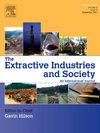Mining, separate development, and uneven impact: Evidence from South Africa’s former homelands during the 2000s commodity boom
IF 4.3
2区 社会学
Q2 ENVIRONMENTAL STUDIES
Extractive Industries and Society-An International Journal
Pub Date : 2025-06-27
DOI:10.1016/j.exis.2025.101709
引用次数: 0
Abstract
This paper investigates how the spatial legacy of South Africa’s Separate Development policy shaped the local impact of mining during the 2000s commodity boom. It focuses on the former homelands – territories created under apartheid to confine Black South Africans to politically excluded, under-resourced areas – many of which coincided with mineral-rich land. The study asks whether industrial mining in these areas contributed to local poverty reduction and employment, or whether historical spatial inequality suppressed those benefits. Despite its significance, there is a lack of empirical evidence on how mining activity affects socio-economic outcomes in these structurally marginalised areas.
First, the paper draws on census data from 1970 to 1991 and secondary literature to trace the origins of spatial poverty in the former homelands, showing how the design of Separate Development entrenched underdevelopment. Second, it uses an original empirical strategy that merges individual-level census data from 1996, 2001, and 2011 with geocoded mining data from over 400 mines.
The analysis compares wards located in former homelands with those in non-former homeland areas, and with non-mining wards within former homelands. The results reveal that while mining activity is generally associated with lower poverty and higher employment, these benefits are significantly weaker in the former homelands. The study also highlights the volatility of mining-linked employment, which closely tracks commodity price fluctuations, especially in marginalised areas.
矿业、独立发展和不均衡影响:2000年代大宗商品繁荣时期来自南非前家园的证据
本文研究了南非独立发展政策的空间遗产如何影响2000年代大宗商品繁荣时期采矿业对当地的影响。它的重点是前家园-在种族隔离时期建立的领土,将黑人限制在政治上被排斥,资源匮乏的地区-其中许多与矿产丰富的土地相吻合。该研究询问这些地区的工业采矿是否对当地的减贫和就业做出了贡献,还是历史上的空间不平等抑制了这些好处。尽管采矿活动意义重大,但缺乏关于采矿活动如何影响这些结构边缘化地区的社会经济结果的经验证据。首先,本文利用1970年至1991年的人口普查数据和二手文献,追溯了原家园空间贫困的根源,揭示了分离开发的设计是如何导致不发达的。其次,它采用了一种原始的经验策略,将1996年、2001年和2011年的个人层面人口普查数据与400多个矿山的地理编码采矿数据合并在一起。该分析比较了位于前家园的病房与非前家园地区的病房,以及前家园内的非采矿病房。结果显示,虽然采矿活动通常与较低的贫困和较高的就业有关,但这些好处在以前的家园明显较弱。该研究还强调了与矿业相关的就业的波动性,这密切跟踪商品价格波动,特别是在边缘化地区。
本文章由计算机程序翻译,如有差异,请以英文原文为准。
求助全文
约1分钟内获得全文
求助全文
来源期刊

Extractive Industries and Society-An International Journal
ENVIRONMENTAL STUDIES-
CiteScore
6.60
自引率
19.40%
发文量
135
 求助内容:
求助内容: 应助结果提醒方式:
应助结果提醒方式:


